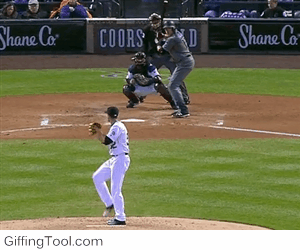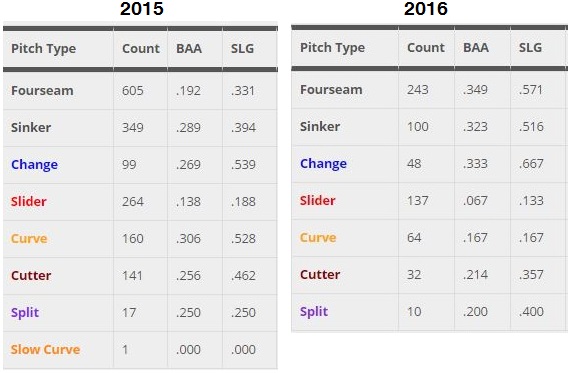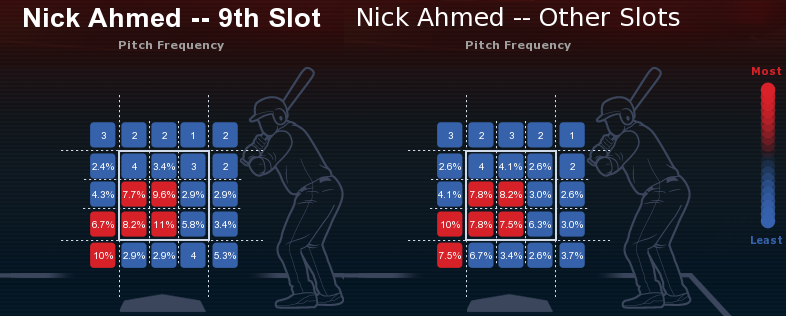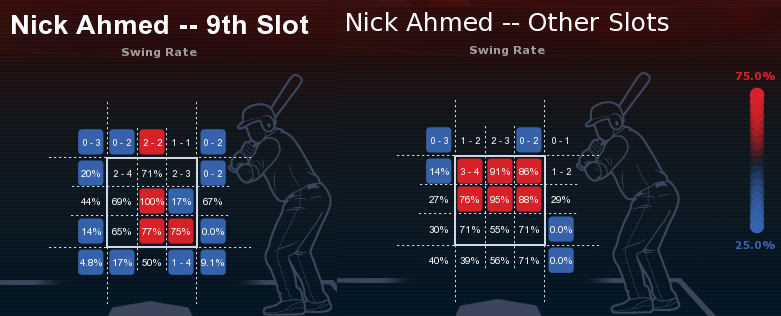Why Nick Ahmed is Better Hitting Ninth
A.J. Pollock is one inspiring fellow. He’s helped Chris Owings with center field, even donating an outfielder’s glove to the cause in the early going. When Jake Lamb changed his swing a bit over the winter, he patterned his approach after Pollock, in part. And Nick Ahmed did the same thing, noting the similarities between his body and Pollock’s. An elite defender at arguably the most important defensive position, Nick Ahmed probably represents the best case scenario in terms of when a player should be started despite a lack of success at the plate. Last season, a 67 wRC+ (33% below average) was enough for his glove to carry him to a 1.7 fWAR in 134 games, the kind of total that may be a hair under “solid regular.”
We probably should have expected some adjustments from Ahmed, who works very hard in the offseason — last season featured some hot stretches, but long periods of time in which Ahmed had little to no success at the plate. To date, though, those adjustments have not helped to keep him on the right side of the Mendoza Line, if he’s been implementing them. With a 39 wRC+, Ahmed has been about 60% worse than league average at creating runs at the plate. The 39 wRC+ brings Ahmed down to a 0.0 fWAR in the early going this season: “replacement player.” And considering that Jean Segura can play a capable shortstop and the team has fielded five second basemen at various positions this year, it’s not like he’s technically irreplaceable, either.
I think Ahmed probably did alter his swing, at least at the beginning of the year — the thing is, I really can’t see it. Fortunately, within the bowels of this web site, there was an answer. From Jeff’s breakdown early last year:
Can you spot the differences? If you said “no,” don’t be alarmed — the difference aren’t stark. He hasn’t vastly altered his stance or added an entirely new timing mechanism. Instead, he holds his hands a touch higher, has a slightly bigger leg kick, coils a bit more now in the load phase and the swing path has a tiny bit more loft. All of that should correlate to Ahmed being able to transfer more power into the baseball.
Reviewing video from the end of last season, early April and early May — it really is hard to pick up. When things are “good,” Ahmed has adjusted to the height of the pitch with his legs, using that “slightly bigger leg kick” to push his body forward in a way where his swing can stay pretty level with the baseball. Here’s the “good” version on a high pitch, a home run at the beginning of the season:
On another high pitch, Ahmed on Tuesday this week:
With the second swing — what does Ahmed’s leg kick really accomplish? And even though the pitch location is similar, Ahmed’s swing path is decidedly less level (this was a weak fly to second). I’m seeing something, but it doesn’t fit the trend of “not there” then “there” then “not there” again. Both kinds of swings have happened intermittently through what I’ve just reviewed.
Not finding a real “change” to start the year with the help of Jeff’s piece from April 2016 — maybe there’s still an overall change in approach I just didn’t detect. If there has been one, I think we probably know the reason: one thing we’ve heard from several players this year is that they’ve been trying to keep the barrel of the bat in the plane of the pitch for a little bit longer. I’m not sure if Ahmed is doing that, but that’s not about breaking pitches — those don’t travel on that same plane. If Ahmed has been having more success keeping the bat level and in the zone longer, that would be about fastballs, and about changeups. And while Ahmed’s atrocious work with the stick doesn’t leave too many positives, he actually has done better against fastballs and changeups, both.
In terms of the regular kinds of stats for individual pitches, I like slugging percentage more than the rest; it gives us an idea of the contact he’s generating, whereas batting average can mean lots of things in samples this small. Take a look:
In the early going, Ahmed has fared tremendously better against fourseam fastballs and sinkers, especially the former — that’s a bump of .240 basis points. Ahmed has already had success on changeups, but he’s improved — that’s not as meaningful as it sounds, because he’s only made contact 9 times, with 3 hits — two singles, and a home run that all on its own raised his SLG on the pitch by over .300 points. Theory confirmed, maybe.
But we know Ahmed hasn’t actually been better overall, and for all his improvement against fastballs — there has to be a drop somewhere. Ahmed has always been chewed up and spit out by sliders, but curveballs — his best pitch last year — have turned into a mighty enemy. Keeping the bat level is not as likely to be important against curveballs, but it looks here a whole lot like he may have gotten worse.
And there’s another thing going on. You may have noticed: Ahmed has done a hell of a lot better out of the 9th spot of the order this season. Try: a 115 wRC+ in 55 PA. Most of his other plate appearances have come 7th in the order (27 PA) and 8th (33 PA), and he hasn’t just been bad there — he’s been impossibly bad: -34 wRC+ and -10 wRC+, respectively. Are the two things related?
Maybe. It does look like pitchers have tried for weak contact less often when Ahmed has been in the ninth spot — there’s a huge change in the rate of cutters, whereas sliders pick up.
But there’s not much else going on here; sinkers stay about the same (when you combine two-seamers, FT, with sinkers, SI), and everything else does, too. In addition, the change in cutters could easily be luck of the draw — not everyone throws one, and we’re only talking 15 games in the 9th slot, 20 in other slots.
It’s location that has changed the most. Compare the pitch frequencies to Ahmed on these maps:
The difference isn’t huge, but there definitely is one — check out the pitches outside the zone, low and away. And keep looking there. Because these are Ahmed’s swing rates by location:
Whoa! In those three little areas outside the zone, low and away: swings 36% of the time when Ahmed is not 9th in the order, but just 12% of the time when Ahmed is 9th. That fits with what we’d think would be the pressure of hitting primarily in front of the pitcher: you’d better swing at what you can, because you won’t get pitches to hit with the pitcher waiting in the wings. When looking at changes in swing percentages and how Goldy has been sucked into a vortex of changing MLB trends, I hinted that Ahmed was an exception to a general D-backs rule that aggressive hitters have tended to outperform expectations this season, patient ones not so much. This is what I was referencing.
Ahmed could be trying to stretch more to cover more than just the plate when hitting in front of the pitcher, with disastrous results — but the good news is, he doesn’t necessarily have to be that aggressive if he doesn’t want to be. And when he hasn’t been, he’s done well. We’ll continue to keep an eye on Ahmed’s swing, and to see whether this batting 9th thing continues as a trend. When Ahmed has had everything firing in the right order, he’s been hitting the ball with authority. No reason why his rebuilt swing should be judged poorly when it’s been used at the wrong times.
2 Responses to Why Nick Ahmed is Better Hitting Ninth
Leave a Reply Cancel reply
Recent Posts
@ryanpmorrison
 Congrats to @OutfieldGrass24 on a beautiful life, wedding and wife. He deserves all of it (they both do). And I cou… https://t.co/JzJtQ7TgdJ, Jul 23
Congrats to @OutfieldGrass24 on a beautiful life, wedding and wife. He deserves all of it (they both do). And I cou… https://t.co/JzJtQ7TgdJ, Jul 23 Best part of Peralta’s 108 mph fliner over the fence, IMHO: that he got that much leverage despite scooping it out… https://t.co/ivBrl76adF, Apr 08
Best part of Peralta’s 108 mph fliner over the fence, IMHO: that he got that much leverage despite scooping it out… https://t.co/ivBrl76adF, Apr 08 RT @OutfieldGrass24: If you're bored of watching Patrick Corbin get dudes out, you can check out my latest for @TheAthleticAZ. https://t.co/k1DymgY7zO, Apr 04
RT @OutfieldGrass24: If you're bored of watching Patrick Corbin get dudes out, you can check out my latest for @TheAthleticAZ. https://t.co/k1DymgY7zO, Apr 04 Of course, they may have overtaken the league lead for outs on the bases just now, also...
But in 2017, Arizona ha… https://t.co/38MBrr2D4b, Apr 04
Of course, they may have overtaken the league lead for outs on the bases just now, also...
But in 2017, Arizona ha… https://t.co/38MBrr2D4b, Apr 04 Prior to the games today, there had only been 5 steals of 3rd this season (and no CS) in the National League. The… https://t.co/gVVL84vPQ5, Apr 04
Prior to the games today, there had only been 5 steals of 3rd this season (and no CS) in the National League. The… https://t.co/gVVL84vPQ5, Apr 04
Powered by: Web Designers@outfieldgrass24
 Starting 2022 with a frigid dog walk sounds just lovely https://t.co/xoLZSZBpGp, Jan 01
Starting 2022 with a frigid dog walk sounds just lovely https://t.co/xoLZSZBpGp, Jan 01 I’ll never forget seeing Kyle Seager at the Scottsdale Fashion Square one March with his family and thinking “damn,… https://t.co/uapNYdsU2a, Dec 30
I’ll never forget seeing Kyle Seager at the Scottsdale Fashion Square one March with his family and thinking “damn,… https://t.co/uapNYdsU2a, Dec 30 Big dogs. Bigger trees. @ Avenue of the Giants, Nor Cal https://t.co/YAdxcE1t1p, Dec 29
Big dogs. Bigger trees. @ Avenue of the Giants, Nor Cal https://t.co/YAdxcE1t1p, Dec 29 Old friend alert https://t.co/7HQjiyBWTB, Dec 27
Old friend alert https://t.co/7HQjiyBWTB, Dec 27 Death wish https://t.co/XJzcMkNPTy, Dec 26
Death wish https://t.co/XJzcMkNPTy, Dec 26
Powered by: Web Designers











[…] Why Nick Ahmed is Better Hitting Ninth […]
[…] differences for Ahmed batting ninth (i.e. behind the pitcher) rather than in front of the pitcher. The gap was big. From last […]